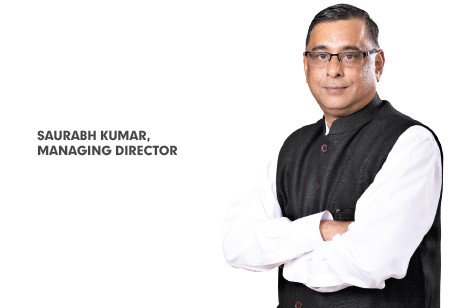Unlocking New Business Scale and Efficiencies through IT
By Saurabh Kumar, Managing Director, Energy Efficiency Services Limited

Saurabh Kumar, Managing Director, Energy Efficiency Services Limited
EESL is a joint venture under the Ministry of Power, Government of India devoted to implementing energy efficiency program for the masses. Saraubh is an electrical Engineer and an environmentalist who has been leading EESL in successfully implementing energy efficiency projects.
Ever since India’s ratification of the Paris Agreement, the world has been paying close attention to our climate change reforms. Our efforts in energy conservation have been commended globally and the world is acknowledging the leadership India is demonstrating in energy efficiency - a simple, transformative and cost-effective climate change solution.
This has been possible because of a conducive policy environment. The Energy Conservation Act of 2001 promotes energy efficiency providing regulatory mandate for standards and labeling of equipment and appliances; energy conservation building codes for commercial buildings; and, energy consumption norms for energy-intensive industries. Simultaneously, the National Mission for Enhanced Energy Efficiency (NMEEE) seeks to strengthen India’s energy efficiency market through favourable regulatory and policy regime, enabling India to avoid annual demand for 19,598 MW, and fuel savings of around 23 million tonnes.
"As digitalization accelerates and creates devices with better computing power and connectivity, it will enable faster and better data for analytics"
One of the most significant interventions for India has been in the domain of consumer-led usage of energy efficient products and services, and includes everything from identifying standards for consumer appliances to enabling a market for adoption of efficient products. However, deployment of efficient products faces barriers like lack of information and consumer awareness of benefits, and a prohibitive cost of ownership. With regulatory and market-based interventions, India has overcome these challenges by using IT as a catalyst to execute what has become the world’s largest energy efficiency programme.
The Government of India’s domestic efficient lighting scheme - UJALA (Unnat Jyoti by Affordable LEDs for All) has adopted IT as an enabler.
Linked to sensors and geo-tagging, a UJALA dashboard enables the masses to see the purchase of energy-efficient LED bulbs, and corresponding savings in energy and carbon costs in real time. With these metrices, prospective buyers can immediately find the closest kiosk retailing the affordable LED based on their location, or register their grievances on a portal. To showcase these benefits to the masses, the government initiated the digital #ILedTheWay campaign, to make LED uptake a citizen’s movement. In the first year of the campaign, over 30 lakh people pledged to switch to LED bulbs, triggering a spike in bulbs distributed across the country.
Similarly, under the government’s national street lighting programme, a Central Control and Monitoring System (CCMS) ensures that urban local bodies, municipalities and public-sector utilities have ease of maintenance in taking care of the LED street lights installed. The lights can be controlled remotely depending on requirements, preventing electricity wastage. As they are linked to an Internet-of-Things (IoT) interface, they can also be monitored remotely, reducing downtime for repair and maintenance. Such digital real-time vigilance will also be achieved by the millions of smart meters that are scheduled for installation, ensuring that utilities and consumers directly receive usage information.
Such efficiencies and benefits are essential for a rapidly urbanising India and its corresponding increase in energy usage. It is the foundation of India’s vision for 100 Smart Cities, which will be equipped with sustainable, modern, efficient urban infrastructure. Implementation of energy efficient pump sets for public water works and sewage systems, and other energy efficient interventions in public lighting, public transport systems and buildings will be made in cities selected under the Smart Cities Mission . This will be followed by similar interventions for Atal Mission for Rejuvenation and Urban Transformation (AMRUT) cities in a phased manner.
Smart Consumption:
Enabling Information and Communication Technology (ICT) to achieve its full potential in designing better energy efficient products and services will require an analysis of current usage. Every single instance of usage - every appliance switched on and every kWh of electricity consumed - offers quantifiable insight. Catalogued and analyzed against historical trends, it can inform the creation of better appliances. This ‘big data’ approach therefore can become the starting point for energy innovation.
To make this measurement of usage trends sharper, the ‘smart meter’, currently a means for electricity measurement to merely fight utility losses, can become a source for analytics that can drive new opportunities. In the coming years, India plans to outfit approximately 35 million customers with smart meters , creating large volumes of potential usage data from various touch points.
Enabled by tele-management systems and wireless consumption analyzers, companies, utilities, businesses, and homes will have complete and real-time information about their consumption and usage behaviour. Awareness of every rupee in the electricity bill and its corresponding carbon cost will ensure a common call to action for all - to adopt energy efficient practices. Ensuring simplicity in how this information is communicated, how quickly users can respond to it will be critical.
A future can be anticipated in which mobile applications, working with a household’s complete set of ‘smart appliances’, can recommend better energy decision making, and enable consumers to make drastic changes to their consumption. The Internet of Things (IoT) therefore has significant relevance for the next phase of energy efficiency.
As digitalization accelerates and creates devices with better computing power and connectivity, it will enable faster and better data for analytics. This enables everyone in the energy value chain - manufacturers, discoms, consumers - to make more informed choices, while creating a more future ready strategy for India’s energy needs.




